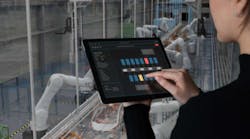The rise of the smarter, swifter and safer production employee
Ericsson recently launched their latest Ericsson IndustryLab Report: The Rise of the Smarter, Swifter, and Safer Production Employee, which found that as facilities become more data-driven and digitalized, and production moves beyond the traditional factory walls, the need for the augmented worker has never been more paramount.
We wanted to learn more, so we chatted with Sebastian Elmgren, Ericsson’s smart manufacturing portfolio manager, and Anders Erlandsson, head of IndustryLab at Ericsson Consumer & IndustryLab. Take a look…
Smart Industry: What was the true impact of supply chain disruption during the worst of the pandemic? Is the problem persisting or waning? Was media coverage of supply chain challenges overblown?
Sebastian: From Ericsson’s we could handle the impact quite well thanks to our global footprint when it comes to production. We have main production sites in Europe, US and Asia and could balance production based on the current impact. Supply chains will continue to be stressed, but the problem is waning.
Smart Industry: What is the most interesting element of the new IndustryLab Report? What would most surprise readers?
Anders: I think the two elements that surprised myself the most were:
A) The fact that such a large portion of the production work is still considered to be dull, dirty or dangerous. According to estimates made by the production employees themselves, no less that 71% of all work is at least one of these! What make this even more interesting is that when we asked the decision makers about their respective production companies success in reducing work tasks that are dull, dangerous and dirty, roughly two in three were very satisfied!
B) The high usage of information and communication technology (ICT)-enabled production tools, and the expected increase in usage over the next three to five years, with seven in ten expecting to use AI, video recognition and remote-controlled machines or vehicles in their production facilities, but also the expected width of usage going forward, with 74% of all production companies expecting to use seven or more of these tools within ten years.
Sebastian: I think the speed of the adaptation of new technologies is the most surprising. This is no longer only in long-term strategies, but here-and-now deployments that are creating value. The Global Lighthouse award that was given to our new 5G Factory in Texas is an example of this. As we are bringing a broad range of new technologies together, we can see significant improvement in productivity and the use of resources.
Smart Industry: What is the relationship between smart production tools and the need for a human workforce? Does this get misconstrued?
Sebastian: The smart production tools are augmenting the human workforce, not substituting it. By focusing on what the humans are best at and removing the dirty, dangerous and dull parts, we can create a better work environment at the same time as we are increasing productivity.
One example of this is the private 5G deployment we have done together with Skogforsk, the Forestry Research Institute of Sweden. In this deployment we are using 5G connectivity to make it possible to remotely control harvesters in the forest. The operator is placed in a safe and ergonomic indoor environment and a better work environment is created. At the same time he/she will be able to perform better when not interrupted by the uneven work environment. Also without the need for a driver cabin on the vehicle, it will become lighter using less fuel and having less impact on the soil while driving in the forest. So this is not about adopting the human workforce and the environment to the smart production tool but the other way around: to have wins in all dimensions.
Anders: Both decision makers and production employees in our IndustryLab study share the view that the key benefit of these tools is to enable humans to be smarter, swifter and safer. Production employees will have cognitive, sensory and motoric tools at their disposal in the future. Having said that, close to half of all surveyed production employees expect to work fewer hours in the future, and only 16% expect to work more.
Smart Industry: Manufacturers are expected to deploy new production tools in the coming five years. What tools are we talking about here? What is most common?
Sebastian: I would say digital instructions, such as augmented reality (AR), and automated material handling are the most common. The increased demand for fast decisions in production creates a need to bring system support to the people in the front line. AR is an excellent tool to make information available on the shop floor that was previously only been available back office. The pandemic has given an extra boost to AR as traveling has been an issue. Ericsson used AR when building our factory during the pandemic. As we could not fly experts to the factory AR was a way for us to bring the experts to the shop floor without leaving their offices around the world. As we for sustainability reasons also in the future will see limited traveling this is a use case that will live on.
For the material handling, this is a logical step based on the automation of assembly that in many industries has been the focus so far. As the assembly process becomes more automated and able to handle more variants material handling becomes the new bottle neck and needs to be automated in order to feed the final assembly. With the introduction of 5G there is now a reliable and secure wireless technology that can support the mobility demands for the material handling use cases.
Anders: In our IndustryLab study, the production tool with the highest penetration right now is AI and remote-controlled machines or vehicles, both with roughly one in three enterprises using it in their production facilities today. Video recognition is similar in current usage, and all these three tools are expected to be used by seven in ten companies within the next five years! As Sebastian mentioned, AR, and to some extent virtual reality (VR), also show significant promise, both expected to be used by two thirds of production companies in the next five years. In fact, the results in our study are not so much indicating winners and losers among these ICT-enabled tools, but what we are rather seeing is a surprisingly homogenous set of tools with very similar expected take-up!
Smart Industry: What is the appeal of ICT-enabled production tools? How are these being used?
Sebastian: From my experience, flexibility is the main driver for ICT-enabled tools. There is a huge demand for mass customization and make-to-order that creates an explosion of variants. Production constantly needs to be optimized based on variants, product mixes and changes in volumes. 5G-enabled production tool makes it possible to cut the cables and more easily reconfigure, the high capacity of the 5G network will make it possible to collect more data from the production lines in order to be on top on what is happening in this ever-changing environment and the low latency will make it possible to take quick decisions based on the data and change any parameters that needs to be changed. We’ve seen this, for example, from our deployment at Atlas Copco where they are developing the next generation of 5G-enabled screwdrivers that will make the transition from wired to wireless tools easier.
Another example comes from the automotive manufacturing industry; we just partnered with Porsche and their manufacturing production complex in Leipzig, Germany. A dedicated 5G network will be piloted in the technology cell of Porsche’s Macan body shop that will enable the control of robotics in real time without cables. It will allow for the transmission of massive amounts of data between other on-site machines, production workers and vehicles through the secure, flexible and predictable transmission of signals in real time.
Anders: In the report, we have attempted to extract the key values for the different tools, and it is clear from our results that while some key values stretch across all the tools, there are also values that are more associated with some, than with others. We have split these tools into three groups:
- Broad enablers such as remote-controlled machines/vehicles and video recognition, are tools with a broad application area across different industries. Remote-controlled machines and vehicles rank highly amongst production employees for reducing dirty and dangerous work, while video recognition on the other hand can cost-effectively reduce dull tasks such as visual inspection of e.g. a production line.
- Augmenters such as AR and exoskeletons, are tools that improve the senses of production employees. AR, as also mentioned earlier by Sebastian, enables production employee to work more efficiently, and with higher quality than today, as e.g. instructions for complicated assembly procedures can be shown to the employee while leaving his/her hands free to work.
- Offloaders (AGV/AMR, collaborative robots) help redistribute production employees work, but can also be seen as significant steps toward automation. While these tools are perceived to bring higher overall value to the production company, not the least with regards to increased productivity, they are also dependent on the overall digital maturity of the production line. Also, offloaders can be used to eliminate dull, dangerous and dirty work tasks.



